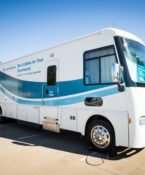Some steps to remember to prevent falls in nasty weather
 |
| Nicoleta Bugnariu, PT, PhD |
Older people are more likely to fall because of balance and gait issues. But rain- and ice-slick surfaces can throw anyone, of any age.
Nicoleta Bugnariu, PT, PhD, Associate Professor of Physical Therapy at UNT Health Science Center, offers this advice to stay upright:
- Remember that an invisible sheet of ice may cover what appears to be a safe surface. And a light dusting of snow may hide a sheet of ice.
- Wear flat shoes with slip-resistant soles or rain/snow boots.
- Walk with your knees slightly bent, feet widely set apart, arms held out to your sides.
- Take slow, short, flat steps. The heels and soles of your shoes should stay in contact with the ground as long as possible.
- Avoid carrying anything heavy.
- Grip a handrail if possible.
- Use sidewalks. Avoid walking in the street. Cars slip and slide, too! If you can’t avoid the street, wear bright or reflective clothing.
- Keep your head warm, but don’t restrict your vision.
- Be aware of overhead hazards. Falling icicles and chunks of ice kill hundreds of people each year.
- Remove your shoes or boots once you get inside. Snow and ice often stick to the soles of shoes and will melt almost immediately as your shoes begin to warm up. The result is a slippery surface and the risk of a fall.
If you feel yourself falling backward:
- Tuck in your chin to protect your head as much as possible.
- Try to roll with the fall.
If you feel yourself falling forward:
- Avoid the urge to use your arms to break your fall – you may do more harm to your body than good.
- Try to land on a part of your body with more padding, such as your buttocks.
![Uyen Sa Nguyen Scaled[58]](https://www.unthsc.edu/newsroom/wp-content/uploads/sites/16/Uyen-Sa-Nguyen-scaled58-145x175.jpg)




Social media